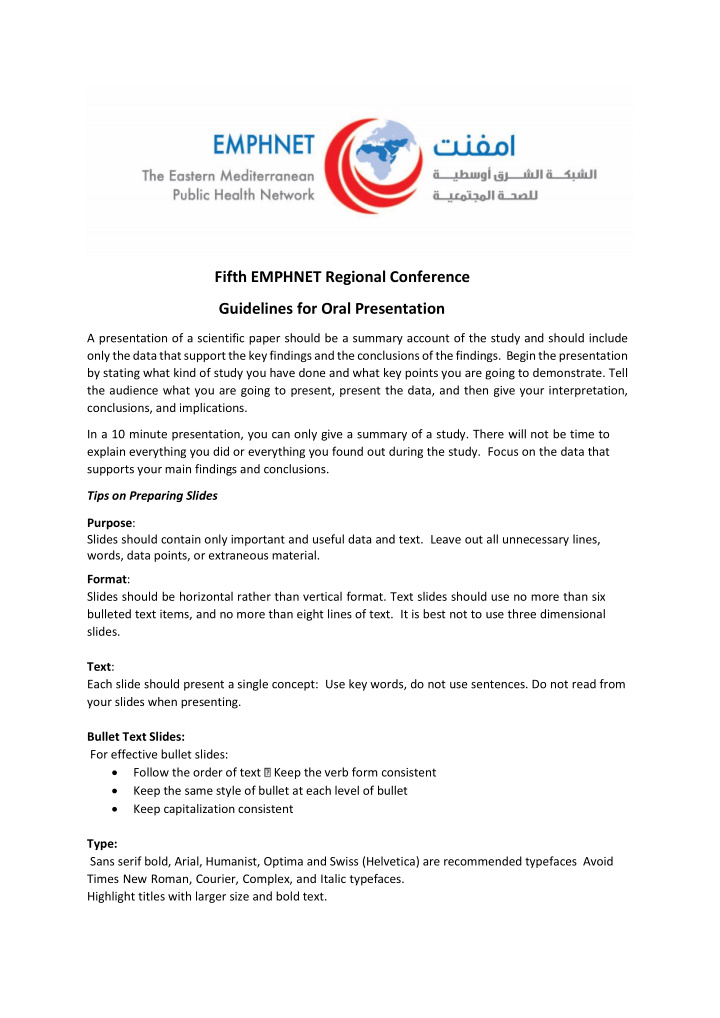



Fifth EMPHNET Regional Conference Guidelines for Oral Presentation A presentation of a scientific paper should be a summary account of the study and should include only the data that support the key findings and the conclusions of the findings. Begin the presentation by stating what kind of study you have done and what key points you are going to demonstrate. Tell the audience what you are going to present, present the data, and then give your interpretation, conclusions, and implications. In a 10 minute presentation, you can only give a summary of a study. There will not be time to explain everything you did or everything you found out during the study. Focus on the data that supports your main findings and conclusions. Tips on Preparing Slides Purpose : Slides should contain only important and useful data and text. Leave out all unnecessary lines, words, data points, or extraneous material. Format : Slides should be horizontal rather than vertical format. Text slides should use no more than six bulleted text items, and no more than eight lines of text. It is best not to use three dimensional slides. Text : Each slide should present a single concept: Use key words, do not use sentences. Do not read from your slides when presenting. Bullet Text Slides: For effective bullet slides: Follow the order of text Keep the verb form consistent Keep the same style of bullet at each level of bullet Keep capitalization consistent Type: Sans serif bold, Arial, Humanist, Optima and Swiss (Helvetica) are recommended typefaces Avoid Times New Roman, Courier, Complex, and Italic typefaces. Highlight titles with larger size and bold text.
Black-on-clear Slides: Black on clear/white slides have a good contrast that can be easily read in a lit room. Color Slides: Most presenters' slides are now in color, a recommended color scheme is a dark blue background with white or yellow text. Distracting Slides have too Much: Information. Color. Use of symbols. Slick packaging. Effective slides are: Simple. Clear. Visible. Final Comment: If your audience remembers more about the composition and appearance of your slides than your message, you ’ ve failed! Tips for Preparing Your Written Presentation Keep in mind that you will be communicating the key findings and importance of your study to a diverse audience. Focus on presenting your message clearly to everyone in the audience, rather than on impressing them with the complexity and enormity of your investigation. Focus on a few key issues and give supporting data for them, rather than presenting many points superficially. Use clear, plain, direct language in your text. Explain epidemiologic associations clearly: Always present the case definitions used Use sentences that describe the people studied, rather the risk factor in question Since most epidemiological studies are observational studies (not clinical trials), it is appropriate to express findings in terms of proportions (percentages of cases and controls with a given factor) and the likelihood that the observed findings occurred by chance (i.e., p- value) When presenting cohort data, use rates and relative risks with confidence intervals. When presenting casecontrol data, use odds ratios and confidence intervals Use incidence vs. prevalence correctly Orient the audience to each slide that presents a figure. Do this by explaining to the audience what is represented by the x-axis, y-axis, and each series in the figure. Do not project a slide with figure on the screen and comment, without looking up and using a pointer. A little humor is acceptable if you have a solid presentation.
Tips for Delivering Presentations Rehearse! Practice! Practice! Practice! Do not begin your presentation at the conference until you are ready Speak slowly and project your voice Look out at your audience Check that the correct slide is projecting Remove each slide when you ’re done with it Use the pointer correctly Make the most of the question-and-answer period When Responding to Questions Take the time to make sure you understand the question. It is very common and normal that a presenter finds it hard to understand or remember the question posed, especially if questioner asks a long question or series of questions. Feel free to ask the questioner for clarification or to repeat the question. Pause for a while to think out your answer. Take a deep breath and gather your thoughts. What may seem like a panic stricken eternity to you will merely seem like a thoughtful pause to your audience Keep in mind that you know more about your own investigation than does the audience. Give short, direct answers. Sometimes you can anticipate some questions and rehearse answers ahead of time. Consider all questions to be queries for information and treat them that way even if they may sound hostile to you. Avoid projecting a defensive attitude. Don't feel that you have to give an answer when you can't or there isn't one. If you are well prepared and confident, you can answer "I don't know" comfortably.
Recommend
More recommend